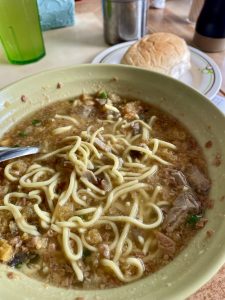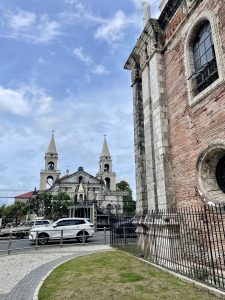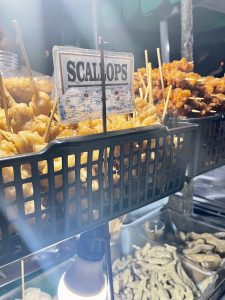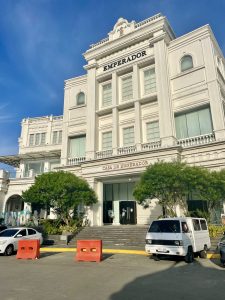by Cathlyn Mae Botor
 “Don’t use a lot where a little will do.” This proverb resonated with me during one of my reads. My 20s have been dedicated to traveling, yet I still forget that it’s not how much I’ve traveled that matters, but how these little experiences, when they all add up, contribute to the renewed version of myself that I always come home to.
“Don’t use a lot where a little will do.” This proverb resonated with me during one of my reads. My 20s have been dedicated to traveling, yet I still forget that it’s not how much I’ve traveled that matters, but how these little experiences, when they all add up, contribute to the renewed version of myself that I always come home to.
I kicked off my Iloilo trip with a hot bowl of La Paz Batchoy from Ted’s. One slurp of the noodle soup felt like a warm embrace. It was a comforting dish, like how sweet-sounding Ilonggas are when they speak. From then on, I knew Iloilo felt like home.
Slow travel can induce a sense of wanderlust without ticking off all places at once. Iloilo had some kind of allure and mystery non-locals like me would be intrigued to decipher. And to my surprise, the city has openly unraveled itself for me.
openly unraveled itself for me.
There are two things I always bring with me: a Google map and my coin purse for jeepney fare. Thanks to the city’s organized transportation system, I never really got lost. Just across Jaro Plaza, electronic jeeps with different signboards convene. Iloilo is implementing an enhanced Local Public Transport Route Plan (LPTRP), where jeepney drivers are each assigned one route from the 25 different routes around the city.
The thoughtful urban planning for Iloilo has helped the city combat overtourism. The attractions are spread out in separate locations, allowing travelers to discover them one at a time. With Iloilo’s rich cultural heritage, the Spanish influence is deeply embedded in the striking architecture of the century-old churches dotting the province.
On a scorching hot day, I visited Miag-ao Church, the only UNESCO heritage-listed parish in Iloilo. It is a 45-minute jeepney ride, one from Jaro and another from Mohon Terminal. A few steps away from Miag-ao Church, I’ve reached the quiet campus of UP Visayas, where shady trees hug the entire landscape.
 Tracing my steps to the nearby beach, I’ve stumbled upon The Box Coffee, a hole-in-the-wall café across the highway from the oblation. I ordered a salted caramel matcha latte to quench my thirst.
Tracing my steps to the nearby beach, I’ve stumbled upon The Box Coffee, a hole-in-the-wall café across the highway from the oblation. I ordered a salted caramel matcha latte to quench my thirst.
The scenic jeepney ride back to the city made me feel sleepy. Only a few vehicles were seen on the road, yet the return trip felt longer than the initial journey. When the jeep stopped to board more passengers, I scooted over to make room for youngsters who seemed like college students. Miag-ao is far from malls and establishments, but with its scenic roads lined with Camachile trees, its beauty remains raw and charming.
I went ahead to catch the 5 o’clock mass at Molo Church. After the mass, I felt a rumble in my belly. Thankfully, the plaza near the church is lined up with food stalls selling bibingkas, fried scallops, calamares, and dynamite lumpia.
In downtown Iloilo, I walked the whole stretch of Calle Real, brimming with Art Deco buildings and old retail stores. The smell of ripe jackfruit stopped me, and when I looked to my right, an old man was dissecting a huge one. “Tag pila ni?” I asked how much a tub costs. I took out 75 pesos from my wallet with a smile on my face.
dissecting a huge one. “Tag pila ni?” I asked how much a tub costs. I took out 75 pesos from my wallet with a smile on my face.
Late that afternoon, people were already queuing outside a Chinese restaurant. I went inside and figured they were making a beeline for the famous Roberto’s siopao. I knew I had to eat siopao for the first time to satisfy my curiosity. The taste? That adobo-flavored siopao is one for the books. Namit gid!
On my way to Plaza Libertad, I’m amazed by how the city maintains its streets. No tangled electrical wires crisscross across the buildings along some portions of Calle Real; instead, the power lines are buried underground.
 At half past four in the afternoon, I stepped into the Philippine Maritime History Museum before its closing. Inside, a freshman college student who was a museum volunteer at that time was kind enough to show me around. It was fascinating to learn about the intricate role of our seas, not only for tourism but for navigation and trade, too.
At half past four in the afternoon, I stepped into the Philippine Maritime History Museum before its closing. Inside, a freshman college student who was a museum volunteer at that time was kind enough to show me around. It was fascinating to learn about the intricate role of our seas, not only for tourism but for navigation and trade, too.
Museum-hopping is just one of the many activities Iloilo has to offer. While my time didn’t permit me to visit all of the museums in the city, I had to check out the Iloilo Museum of Contemporary Art (ILOMOCA), with five galleries spread across three floors at the Casa Emperador Building. One particular artwork caught my attention. It depicted the controversial West Philippine Sea dispute, which made me question the freedom I am privileged to feel. In the archipelagic nation we live in, are we truly free?
I was fortunate enough to visit Iloilo in late March, when we were still celebrating National Women’s Month. Ilonggas are incredibly innovative and resilient, and they can take on roles men used to dominate. While touring the city, I’ve met bus conductors who are women, and I’m amazed at how strong they are for being able to stand all day amidst the heat just to cater to passengers.
Going beyond tourist routes allowed me to gain insight into the local city scene without the pressure of checking out the places tourists are itching to visit. The walkable streets and bustling laneways lead me to quaint spots where locals gather to rest.
The Iloilo River Esplanade is an ideal refuge, offering a recreational space for leisurely walks and afternoon jogs. Kalachuchi trees out here are in full bloom. I walk towards the middle portion of the esplanade and pick up a pink Kalachuchi flower on the path. I liked the smell of it, as it reminded me of why summer is my favorite season.
I end the day catching the last ray of sun glittering over the city. Nothing beats provincial life as it allows us to slow down, appreciate the small things in life, and forget about our worries for a little while. This is what slow travel does. It gives us a little reminder of why traveling should remain simple but meaningful, and what a privilege it was for me to experience all this in the quaint and quiet space of Iloilo.



Loved reading this! It makes me so happy knowing you enjoyed my hometown. Next time, let’s plan a trip together and go on more food trips and explore those charming spots you found. Iloilo still has a lot to show you, and trust me, there’s so much more we can do and eat! I’d be happy to tag along. 😍
The Sunset Boulevard at dusk. It’s right after Esplanade 2. People and visitors congregate here at dusk to watch the sunset. Then, come back to Molo Plaza to see the fully lighted MOLO CHURCH AND the MOLO MANSION. Then, head over to JARO PLAZA to see also the fully lighted plaza, the JARO CATHEDRAL, and the magnificent JARO BELFRY and the newly installed fountain. Then csl yiuinight with dinner at the nearby AGATONA 1927 RESTO or at BALAY SUEÑO nearby, or at BALAY REMEDIOS at Bonifacio drive. Or you can go sesfootat the ILOILO FISHING PORT Or at the other restaurants.